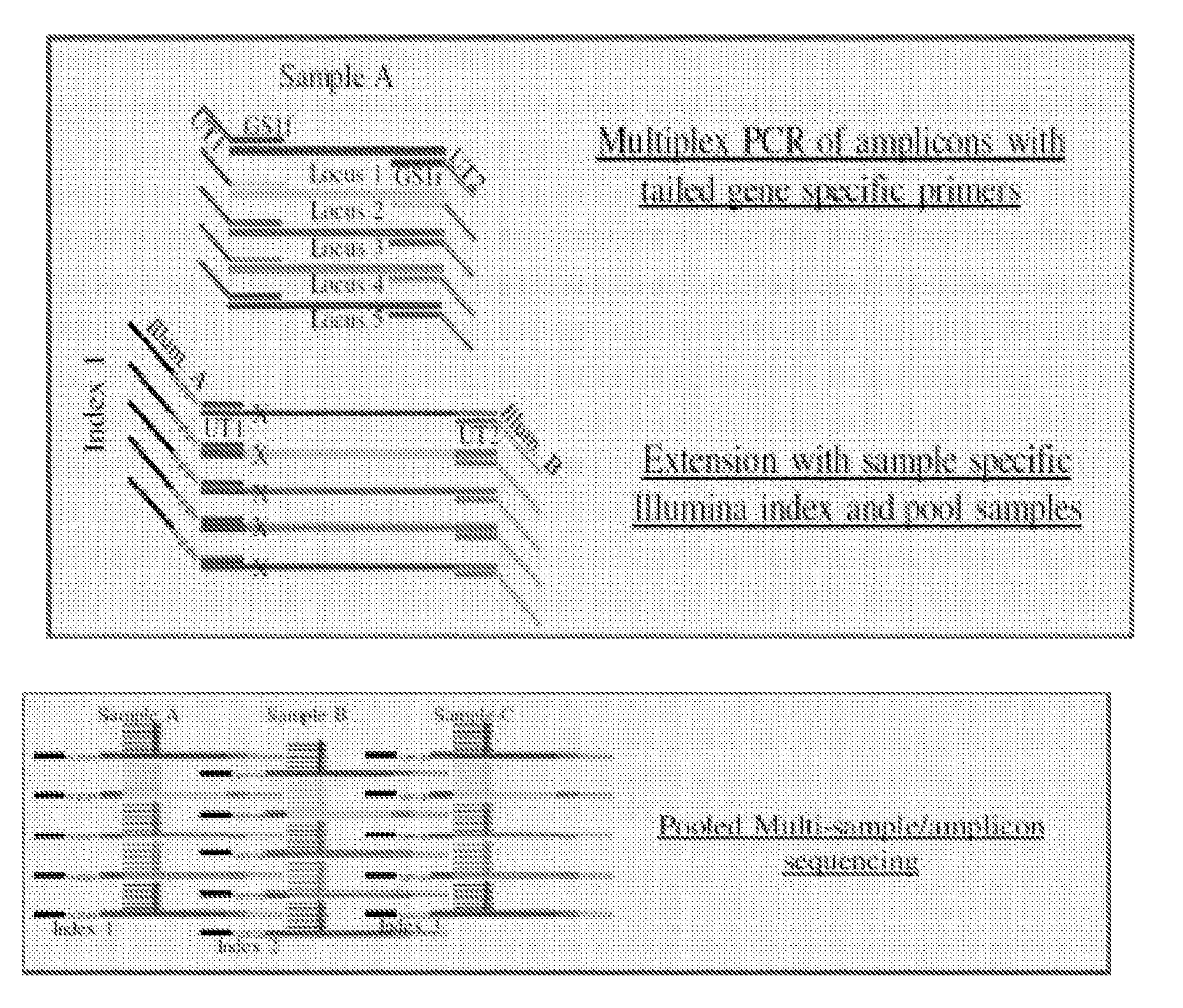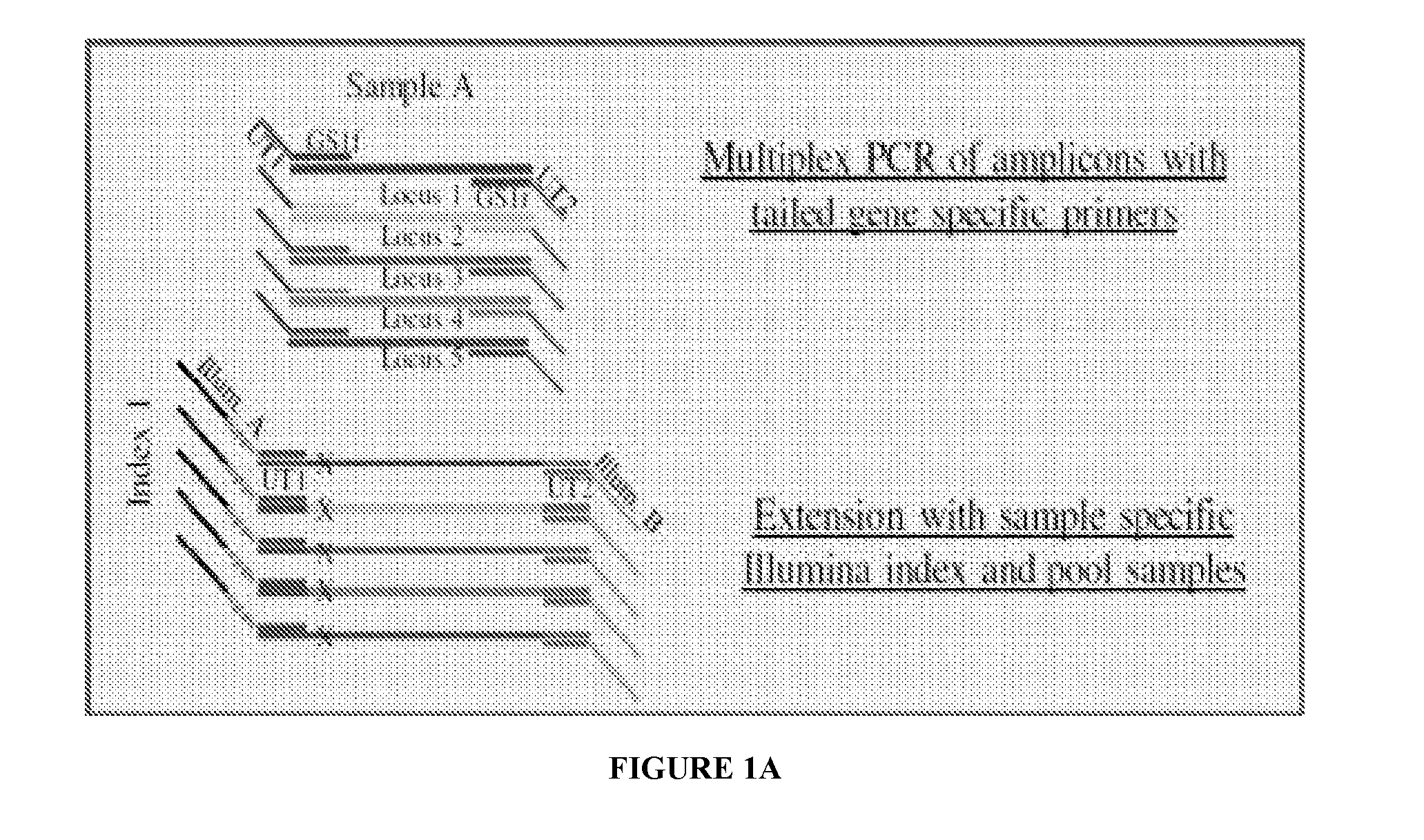Systems and methods for universal tail-based indexing strategies for amplicon sequencing
a technology of amplicon sequencing and indexing strategies, applied in the field of systems and methods, can solve problems such as cumbersomeness and high cos
- Summary
- Abstract
- Description
- Claims
- Application Information
AI Technical Summary
Benefits of technology
Problems solved by technology
Method used
Image
Examples
example 1
Universal Multiplex Indexing Strategy for ILLUMINA® Next Generation Amplicon Sequencing Process
[0081]Referring to FIGS. 1 and 2, embodiments of the invention can be used as a universal multiplex indexing strategy for the ILLUMINA® Next Generation amplicon sequencing process. As used in this example, a multiplex PCR is performed with a total of five amplicons per reaction contemplated. In particular, each amplicon is considered to be associated with a different marker (e.g., antibiotic resistance genes). As such, to amplify each marker, the PCR reaction mixture is provided with five unique forward primers and five unique reverse primers (i.e., each primer designed to bind to a marker-specific sequence). Moreover, as shown in FIG. 1, the forward primers comprise a first universal tail sequence (UT1) at the 5′ end of the respective primers, with the universal tail sequence being identical for each of the forward primers in the reaction mixture. Similarly, the reverse primers comprise a...
example 2
Universal Tail Amplicon Sequencing Assay for Use with Samples Containing Mycobacterium tuberculosis
[0084]The following protocol was used to prepare and sequence amplicons from samples containing Mycobacterium tuberculosis.
Target Amplification
[0085]Primer sets targeting Mycobacterium tuberculosis gene regions were used (see Table 1). The target amplicons were between 180-400 bp long. The size of the amplicons was dependent on the positions of the SNPs and the constraints of the length of the sequencing read. Along with organism specific sequence, each primer has a universal tail sequence (bold sequences in Table 1). All forward primers have one universal tail sequence while all the reverse primers have a second universal tail sequence. In Gene Specific multiplex PCR reactions, all target amplicons are synthesized with the universal tail sequence added to the amplicons. The PCR parameters are as follows: initial denaturation at 98° C. for 1 min, twenty-five cycles of denaturation at...
example 3
Universal Tail Amplicon Sequencing Assay for Use with Samples Containing Burkholderia pseudomallei and Burkholderia mallei
[0088]The protocol outlined in Example 2 was used to prepare and sequence amplicons from samples containing Burkholderia pseudomallei and Burkholderia mallei.
[0089]The primers specific to Burkholderia pseudomallei and Burkholderia mallei are outlined in Table 2.
[0090]FIG. 5 shows consistent PCR amplification and Illumina® index extension (peaks on chromatogram) for 12 diverse Burkholderia pseudomallei and Burkholderia mallei isolate DNA samples, using the oligos listed in Table 2 in a multiplex fashion.
[0091]Twelve genomic DNA samples were amplified using the Bp / Bm UT multiplex amplicon assay. Arrows in the Bp_406e panel indicate peaks corresponding to each amplicon. Optimal amplification occurred in all 12 samples Sizing standards failed during the run, but relative peak sizes and migration rates indicate successful amplification in all samples. Sequencing res...
PUM
| Property | Measurement | Unit |
|---|---|---|
| temperature | aaaaa | aaaaa |
| antibiotic resistance | aaaaa | aaaaa |
| resistance | aaaaa | aaaaa |
Abstract
Description
Claims
Application Information
 Login to View More
Login to View More - R&D
- Intellectual Property
- Life Sciences
- Materials
- Tech Scout
- Unparalleled Data Quality
- Higher Quality Content
- 60% Fewer Hallucinations
Browse by: Latest US Patents, China's latest patents, Technical Efficacy Thesaurus, Application Domain, Technology Topic, Popular Technical Reports.
© 2025 PatSnap. All rights reserved.Legal|Privacy policy|Modern Slavery Act Transparency Statement|Sitemap|About US| Contact US: help@patsnap.com



